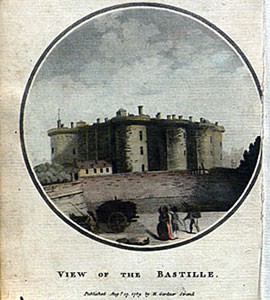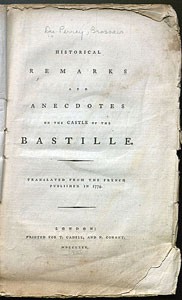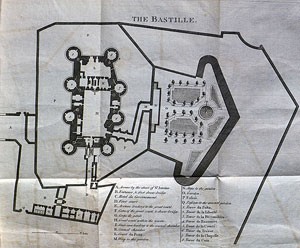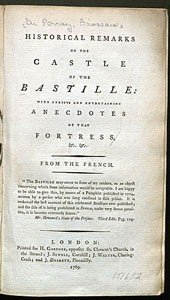The Bastille: “a place even the innocent must be afraid of.”[1] Parisians whispered of the prison’s rat-infested dungeons, torture machines, bread-and-water rations, and secret murder-rooms from which no prisoner ever emerged.
The Bastille embodied the French monarchy’s despotic rule, and as such, it was the first institutional casualty of the French Revolution. On today’s date in 1789, a mob of insurgents stormed the Bastille, liberated the few prisoners that remained, and massacred the guards, prison directors, and other staff.
Fear and Rumors
 Although the Bastille could only hold around 50 prisoners, the rumors and mystery that surrounded it caused the prison to loom large in French culture. Rebellious subjects, religious dissenters, journalists, common criminals and those who simply incurred the king’s displeasure were all confined there. No one really knew what happened in the Bastille; prisoners were forced to take an oath of secrecy, promising never to divulge anything they saw or heard while inside the walls.
Although the Bastille could only hold around 50 prisoners, the rumors and mystery that surrounded it caused the prison to loom large in French culture. Rebellious subjects, religious dissenters, journalists, common criminals and those who simply incurred the king’s displeasure were all confined there. No one really knew what happened in the Bastille; prisoners were forced to take an oath of secrecy, promising never to divulge anything they saw or heard while inside the walls.
In 1715, Constantin de Renneville, a spy who was imprisoned in the Bastille for eleven years, was the first to break the oath. Writing from the safety of England, Renneville published a dramaticized chronicle of his sufferings entitled L'inquisition Françoise, ou, l'histoire de la Bastille.
Following Renneville’s example, former Bastille inmates published tell-all pamphlets at sporadic intervals throughout the eighteenth century. These tales fueled the fear and speculation surrounding the prison. Were the pamphlets simply the sensationalized stories of a few unfortunates? Or did they tell of typical experiences at the Bastille? No one knew.
Bringing the Bastille to Light
 In 1774, a different type of pamphlet was published: Remarques historiques et anecdotes sur le château de la Bastille. The anonymous author described the Bastille in “seemingly objective terms, systematically and with exact figures (including a ground plan), and presenting individual cases only in an appendix.”[2]
In 1774, a different type of pamphlet was published: Remarques historiques et anecdotes sur le château de la Bastille. The anonymous author described the Bastille in “seemingly objective terms, systematically and with exact figures (including a ground plan), and presenting individual cases only in an appendix.”[2]
Like earlier anti-Bastille pamphlets, Remarques historiques was soon translated, becoming Historical Remarks on the Castle of the Bastille in English. For the first time, Europe saw, in relatively matter-of-fact terms, the treatment to which state prisoners were subject.
All the towers are closed below by strong double doors, with large bolts let into enormous locks. The dungeons under the towers are filled with a mud which exhales the most offensive scent. They are the resort of toads, newts, rats, and spiders. In a corner of each is a camp bed, formed of iron bars, soldered into the wall, with some planks laid upon them. In these are put prisoners whom they wish to intimidate, and a little straw is given them for their bed. Two doors, each seven inches thick, one over the other, close these dark de ns: each has two great bolts, and as many locks. … There are five ranks of chambers. The most dreadful next to the dungeons, are those in which are iron cages or dungeons. Of these there are three. These cages are formed of beams lined with strong iron plates. They are six feet by eight.[3]
ns: each has two great bolts, and as many locks. … There are five ranks of chambers. The most dreadful next to the dungeons, are those in which are iron cages or dungeons. Of these there are three. These cages are formed of beams lined with strong iron plates. They are six feet by eight.[3]
Torture chambers and murder rooms fail to appear in this description of the prison, and the author notes that “It sometimes happens that prisoners die in the Bastille by secret means; but the instances are rare.”[4] Historical Remarks also includes precise descriptions of the prisoners’ furnishings, provisions, health care, and communication with the outside world.
Revolution
Remarques historiques was quickly banned in France, but not before it had an effect. The precise details in the pamphlet injected a dose of reason into sensationalist anti-Bastille journalism and galvanized the underground press into a more radical and intense criticism of the government.
 In the rest of Europe, the pamphlet gained acceptance as a true and accurate depiction of the Bastille. English editions of the pamphlet came out in 1780 and 1784, and a new translation was issued after the storming of the Bastille in 1789. The English criminologist and reformer John Howard endorsed it as “the best account of this celebrated structure ever published” and included content from the pamphlet in his survey of European penitentiaries.[5]
In the rest of Europe, the pamphlet gained acceptance as a true and accurate depiction of the Bastille. English editions of the pamphlet came out in 1780 and 1784, and a new translation was issued after the storming of the Bastille in 1789. The English criminologist and reformer John Howard endorsed it as “the best account of this celebrated structure ever published” and included content from the pamphlet in his survey of European penitentiaries.[5]
The revolutionaries that conquered the Bastille in 1789 paraded through the streets of Paris with keys, weapons, and the heads of prison guards and officials on pikes. Demolition of the hated structure began that very night, and within six months, the prison had disappeared. Today, only the foundations remain.
Read More
Historical Remarks on the Castle of the Bastille. London: Printed for T. Cadell and N. Conant.
1780 Edition | 1784 Edition | 1789 Edition
Hans-Jürgen Lüsenbrink and Rolf Reichardt. The Bastille: A History of a Symbol of Despotism and Freedom. (Durham, NC, 1997). DC167.5 .L8713 1997
Christopher Prendergast. The Fourteenth of July. (London, 2008). DC167 .P74 2008
[1] Extract from a letter, 15 July 1789, quoted in Lüsenbrink and Reichardt, The Bastille: A History of a Symbol of Despotism and Freedom (Durham, NC, 1997), 13.
[2] Lüsenbrink and Reichardt, 18.
[3] Historical Remarks (1780), 5-6.
[4] Historical Remarks (1789), 55.
[5] Historical Remarks (1789), title page.